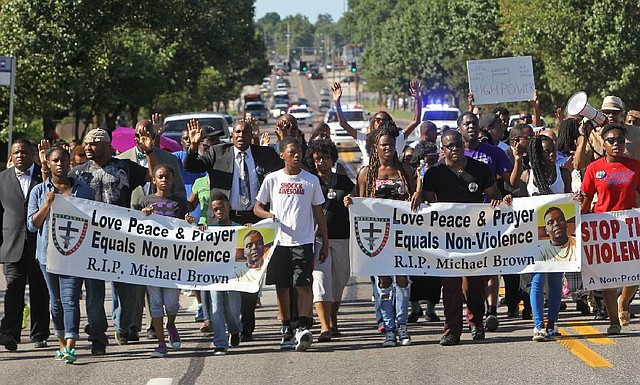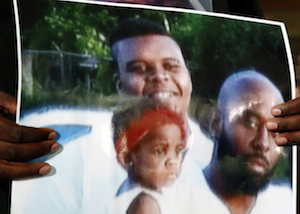Protests again violent near St. Louis
Molotov cocktails, tear gas fly in suburb where teen was killed
A march organized by area ministers to stop violence makes its way down West Florissant Avenue in Ferguson, Mo., on Wednesday.
Thursday, August 14, 2014
FERGUSON, Mo. -- Protests turned violent Wednesday night in a St. Louis suburb that has been rocked by racial unrest since a white police officer shot and killed an unarmed black teenager, with people throwing Molotov cocktails at police who responded with smoke bombs and tear gas to disperse the crowd.
The city has seen demonstrations, street clashes and looting since the weekend shooting of Michael Brown, an 18-year-old who was about to enter college. Ferguson Police Chief Thomas Jackson said earlier Wednesday that the St. Louis County investigation of the shooting could take weeks to complete.
In the meantime, he said, his department welcomes Justice Department training on racial relations in the suburb, where two-thirds of the 21,000 residents are black, while all but three of the police force's 53 officers are white.
"Unfortunately, an undertow [of racial unrest] has bubbled to the surface," said Jackson. "Race relations is the top priority right now."
While Jackson said he wanted to mend fences with the community, protesters were on the streets of Ferguson again Wednesday, facing heavily armed police who at times trained weapons on them from an armored truck. The situation became more tense after nightfall, with police officers ordering people to go home and then using smoke bombs and later tear gas after some people threw Molotov cocktails at them.
An Associated Press photographer witnessed the events. St. Louis County police spokesman Brian Schellman said he had no immediate information about the situation.
Also Wednesday, journalists Wesley Lowery of The Washington Post and Ryan Reilly of website The Huffington Post said they were handcuffed and put into a police van after officers went in to clear a fast-food restaurant where they were doing some work. The Post reported that Lowery was slammed against a soda machine and plastic cuffs were put on his wrists. The reporters were later released without any charges.
Martin Baron, the Post's executive editor, issued a statement saying that "there was absolutely no justification" for Lowery's arrest and that the organization was appalled by the officers' conduct.
Jackson did not immediately return a cellphone message Wednesday night seeking comment.
Earlier, police in Ferguson asked protesters to peacefully rally only during daylight hours. The plea came after an officer shot and critically wounded a man accused of pointing a handgun at the officer early Wednesday. A woman also was shot in the head and wounded during street demonstrations overnight, Jackson said.
The shooting by the officer occurred at 1 a.m. CDT after St. Louis police received a call that four people wearing ski masks and armed with shotguns were in the area, according to a statement from police.
"When officers arrived, multiple subjects began running from the scene. One officer encountered a subject who brandished a handgun, pointing it directly at the officer. Fearing for his safety and the safety of others in the area, the officer fired shots, striking the subject," the police statement said.
"The subject was transported to a local hospital, where as of this writing, he is listed in critical condition. The subject's handgun was recovered by police at the scene," the statement said. No other details were released.
In the shooting involving the woman Wednesday morning, local media reported that she was shot in the head during a drive-by shooting near the Ferguson QuikTrip gas station that had been looted and burned over the weekend and which has become a gathering point for demonstrators this week.
She was conscious after being shot, and she called 911, Jackson said. He couldn't provide further details. Police were reportedly seeking four to five men.
Racial tensions have simmered since the Saturday shooting of Brown.
Police have said Brown was shot after an officer encountered him and another man on the street. They said one of the men pushed the officer into his squad car, then physically assaulted him in the vehicle and struggled with the officer over his weapon. At least one shot was fired inside the car.
The struggle then spilled onto the street, where Brown was shot multiple times. In their initial news conference about the shooting, police didn't specify whether Brown was the person who scuffled with the officer in the car and have refused to clarify their account.
Jackson said Wednesday that the officer involved suffered swelling facial injuries.
Dorian Johnson, who said he was with Brown when the shooting happened, said the officer ordered them out of the street, then tried to open his door so close to the men that it "ricocheted" back, apparently upsetting the officer. Johnson said the officer grabbed his friend's neck, then tried to pull him into the car before brandishing his weapon and firing.
He said Brown started to run, and the officer pursued him, firing multiple times. Johnson and another witness said Brown was on the street with his hands raised when the officer fired at him repeatedly.
Some protesters Wednesday raised their arms above their heads as they faced the police. Others held signs asking for answers about Brown's death.
Michael Brown Sr., the 18-year-old's father, asked for those who are seeking justice in the case to keep their protests nonviolent.
"I need all of us to come together and do it right, the right way, so we can get something done about this," he said. "No violence."
Information for this article was contributed by Matt Pearce of the Los Angeles Times; and by Jim Suhr, Jim Salter, Jeff Roberson and Alan Scher Zagier of The Associated Press.
A Section on 08/14/2014
26515390

